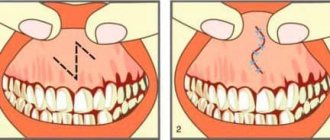Indications
A short frenulum in the form of a longitudinal fold is located between the head and the movable flesh of the penis. Nerve fibers, blood vessels and lymph nodes are focused in this area, providing irritability to the organ.
The sensitivity of the frenulum is much higher than in the head of the penis, which increases excitability and brings orgasm closer. It acts as a natural regulator of a man’s erection, is responsible for tensioning the flesh during sexual intercourse, directs the bending of the head, and determines the displacement of the prepuce.
Most men are sure that the problem of organ performance in such a situation can be solved by circumcision of the foreskin, but doctors recommend this operation only in a hopeless situation.
A positive result is achieved by a simple surgical intervention - short frenuloplasty or frenulotomy. This is the name for dissection of the frenulum of the foreskin or, in some cases, removal of altered tissue resulting from scarring.
Plastic surgery frenulotomy is recommended for the following indications:
- changes and injuries of the genital organ;
- the occurrence of pain during sexual relations;
- bleeding as a result of mechanical damage;
- violation of the flesh of the head due to insufficient secretion (rupture, crack);
- uncontrolled ejaculation caused by the congenital structure of the short frenulum;
- incorrect positioning of the penis during arousal;
- prolonged feeling of discomfort in the head area (tension, tension);
- scarring of the skin at the site of ruptures;
- development of phimosis (narrowing of the foreskin opening).
During close contact, if pain occurs and bleeding develops, the person, trying to prevent a re-rupture, often restrains himself. Both physically and psychologically, this leads to difficulty completing orgasm. Against this background, an irreversible consequence develops - complete or partial erectile dysfunction. Therefore, if you notice any of the above symptoms, you should consult a doctor for advice.
Complications after frenuloplasty
Like any other operation, frenuloplasty can be complicated by wound inflammation, bleeding and the formation of a rough scar.
Infectious and inflammatory complications can develop both as a result of violation of the rules of asepsis during surgery, and due to improper treatment of the wound in the postoperative period and during dressings. Prevention of this type of complications is strict adherence to hygienic requirements during and after surgery.
Bleeding may occur in the first day or two after surgery and is sometimes quite profuse. The cause may be insufficiently reliable suturing of the vessels during surgery or a violation of the blood coagulation system. To prevent bleeding, it is necessary to perform thorough hemostasis with control of all vessels, as well as a mandatory preoperative study of the coagulation system (coagulogram).
The formation of a rough scar after frenuloplasty is an unpleasant problem from both a cosmetic and functional point of view. A rough scar in the frenulum area can be a source of hypersensitivity and premature uncontrolled ejaculation.
The use of modern technologies, such as laser and radiosurgical knife, as well as careful treatment of tissues and the use of modern suture material, allow us to avoid this problem.
From my own experience, I can say that over the past ten years I have not had a single complication after frenuloplasty.
Contraindications
Frenulotomy of the short frenulum is considered a simple surgical operation. However, there are contraindications, which are diseases or inflammations occurring in the body:
- renal or liver failure;
- acute infectious diseases, inflammatory processes accompanied by fever;
- disturbances in the functioning of the genitourinary system;
- diseases associated with blood clotting disorders;
- scarring of the foreskin;
- organ oncology;
- sexually transmitted infections;
- complex diseases of the immune system (HIV);
- temporary decompensation.
What causes the problem?
In most cases, short frenulum of the penis is a congenital problem. It is impossible to detect defects right away, since almost all boys under seven years of age have phimosis, and it occurs in combination with a short frenulum of the penis. After seven years, this problem may go away on its own without surgery, but about 5% remain with it. So a short upper frenulum in a child is not yet a reason to sound the alarm and contact specialists; perhaps everything will work out without outside help.
An acquired short frenulum in an adult can occur under a number of circumstances:
- rigid and sudden movements of the organ during sexual intercourse;
- hazardous sports;
- tight clothes, underwear;
- damage to the flesh by an earring (piercing);
- inflammatory processes;
- sexually transmitted diseases;
- diabetes.
Advantages of the technique
To eliminate problems with the function of the short frenulum, a surgical method is used. The size of the skin cord can only be changed through surgery. No folk remedies or conservative methods will bring positive results.
The frenulum lengthening procedure itself does not take long. Patients of all ages turn to doctors for help. As part of the preliminary preparation, appropriate tests and preparatory measures are required. These include:
- blood test to assess the general condition of the body;
- testing for the presence of diseases such as hepatitis, immunodeficiency, and sexually transmitted infections;
- Diagnostics of blood clotting.
It is important to take measures to stabilize blood pressure levels in order to prevent changes in indicators. In case of injury with heavy bleeding, blood supplies of a suitable type are needed.
Older men are at risk of developing hypokalemia (potassium deficiency). In this case, drugs containing potassium are prescribed.
At the preparatory stage for frenulotomy, the patient has no restrictions on food or liquid. It is recommended to strictly abstain from alcoholic beverages two to three days before surgery.
Important points
If the pediatrician has prescribed surgery for your child, there is no point in delaying it, much less refusing it. It is only nominally a surgical intervention, but in fact it is very quick and easily tolerated. If parents knew all the intricacies of the process, they would no longer be afraid of this procedure.
Best age
The period when it becomes necessary to trim the frenulum under the tongue in children is determined strictly individually. If the baby cannot suck normally, then the procedure can be performed on the second day after birth. This has a big advantage - the frenulum is still devoid of innervation and blood vessels. The manipulation is performed in a couple of minutes using ordinary surgical scissors without any anesthesia. The newborn does not feel anything.
If the baby is eating and developing normally, the shortened frenulum may not be immediately noticed. The defect is noticed when the baby begins to actively communicate, and this happens differently for everyone.
Usually, already at 2-3 years it becomes clear that normal articulation is difficult. Then you need to immediately show the child to a speech therapist.
But this does not mean that surgery is necessary. An experienced speech therapist will begin to perform special frenulum stretching exercises with a young patient. And about half the time, hard work produces great results. Of course, parents will also have to get involved in the process and train with their baby at home. But if after six months of training there are no significant changes, a decision is made to trim.
Preparation for the procedure
For children older than one year, pruning is done under local anesthesia. This may be an injection or treatment of the oral cavity with lidocaine. Since deep anesthesia is not used, there is no need for a thorough preoperative examination. Only a few basic tests are performed:
- general analysis of urine and blood;
- clotting test;
- determination of sugar level;
- fluorogram.
If a child has injuries or wounds in the oral cavity or many damaged teeth, he will first have to visit a dentist. There should be no infection - this is the main condition for the healing of the postoperative wound to occur as quickly as possible.
In the presence of chronic diseases, a conclusion from an observing specialist may be required, since in case of their exacerbation no surgical interventions are performed.
Try to ensure that before the procedure the child does not become hypothermic and does not “catch” some kind of infection. Weak and often sick children may be prescribed a course of immunomodulators.
Execution technique
The technique is very simple. The whole process takes no more than 20-30 minutes, and when using a laser it takes even less, since no stitches are required afterwards. This is the main advantage of laser technology - it immediately seals the wound, and the operation is almost bloodless.
Schematically it looks like this:
- The baby is seated in a special chair and the head is fixed.
- The oral cavity is treated with an anesthetic.
- When sensitivity decreases sufficiently, the frenulum is lubricated with iodine.
- It is dissected using a regular scalpel or laser.
- Tiny stitches are placed if necessary.
After about an hour, the child can already be taken home. Now the most important thing is to strictly follow all the doctor’s recommendations. Removal of sutures is usually not required - they are made from absorbable materials.
The operation to trim the upper frenulum on the lip in children is performed in approximately the same way. If it is too short and inelastic, the baby will also have problems with sucking and facial expressions. Sometimes this can become a noticeable cosmetic defect, since the lip is strongly upturned and exposes the teeth and even gums. After cutting it, everything falls into place.
Recovery
The recovery period after cutting the frenulum of a child’s tongue is very short – only a few days. Complications are extremely rare if the following rules are strictly followed:
- during the first two hours it is advisable not to eat or drink;
- the first day only liquid or pureed food is allowed;
- For a couple of days, it is advisable to constantly remind the baby that you cannot talk a lot and laugh loudly;
- for another 3-4 days you can’t do anything irritating: bitter, sour, salty, food with small crumbs;
- for a week, the oral cavity is rinsed with an antiseptic solution every time after eating.
To speed up healing, the doctor may prescribe a locally anti-inflammatory ointment that promotes rapid skin regeneration. It must be used according to the instructions. Lubricating the wound with iodine or using other rinses on your own is strictly prohibited.
To prevent a hard scar from forming after cutting, on days 7-10 they begin to do special stretching exercises with the child. The load must be increased gradually. The mucous membrane overgrows quickly, so if gymnastics for the tongue are performed correctly, there will be no separation of the seams.
Algorithm for the frenulotomy procedure
- At the first stage, the skin of the patient’s inflamed area is carefully treated with a disinfectant.
- Then anesthesia is administered. During anesthesia, the age characteristics of the person are taken into account. For adolescents under 12 years of age, the drug is administered intravenously; for older patients, it is administered directly into the penis.
- When the anesthesia begins to take effect, the surgeon begins the operation. The frenulum is transversely dissected with a scalpel, a bandage (ligature) is applied to the sectional artery, then longitudinal sutures are applied to the resulting wound.
- If there is an old scar formed for one reason or another, it is removed immediately.
- At the end, apply a gauze bandage.
The frenulotomy procedure and the preparatory stage for it take only half an hour. After which the patient returns to daily activities, as hospitalization is not required.
In plastic surgery, there is another method of cutting the short frenulum - Y-Plasty. It differs in the way the cut is made. But she is not popular with doctors. When it is carried out, in addition to an unaesthetic incision, narrowing of the flesh is also possible, leading to physical complications. As a result of using this technique, there is a high risk of developing phimosis.
Prevention
After the operation, the patient is recommended to follow preventive measures to prevent the development of inflammation resulting from infection at the operated site. These include compliance with the following recommendations of the attending physician:
- use of disinfectants to treat wounds;
- abstaining from sexual intercourse or masturbation until complete healing;
- maintaining personal hygiene, constant care of the genitals;
- refusal to visit a bathhouse or sauna, or an excessively hot bath.
Frenulotomy is performed in a network of clinics and centers located in Moscow and the Moscow region, the contacts of which are listed on our website. We offer a full range of services for patients of all ages: diagnostics, plastic procedures, postoperative care. There are qualified urologists, embryologists and other doctors specializing in this area.
Detailed information, address and opening hours are available on the clinics’ websites, where you can make an appointment for a preliminary examination and required treatment procedures.
Prices for frenulotomy vary between 5-10 thousand rubles. The cost depends on the scope of the examination, the complexity of the operation, as well as the qualifications of the doctor and the status of the hospital where the treatment is expected to be performed.
Reviews from men who have had frenulotomy are positive. In general, the majority note painlessness, rapid wound healing, elimination of the risk of scarring, a short rehabilitation period, and complete restoration of impaired penile functions.
Rehabilitation period
The simplicity of the operation allows the patient to go home on his own on the same day. For several days there may be discomfort when going to the toilet, and swelling is possible. Recovery after surgery takes from a week to two. Also, the necessary recommendations will be drawn up by your doctor. Usually, this is a course of antibiotics, painkillers, comfortable clothes and underwear, exclusion of agitation for up to 1 month, refusal of sports, baths, and swimming pools. If these rules are followed, a quick recovery and no complications are guaranteed.










